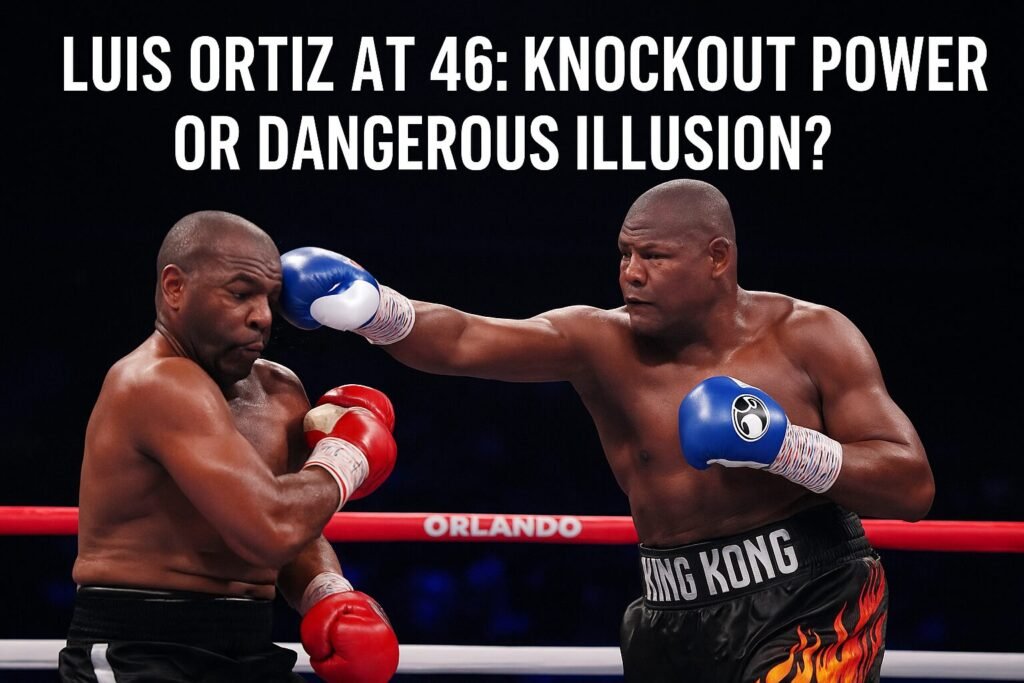Luis Ortiz is 46 years old. He’s heavier than ever. He’s been inactive for years. And yet, in Orlando, he walked into the ring and produced the one thing fans love most: a highlight-reel finish. A vintage Luis Ortiz knockout, delivered in the first round, that looked like something from his prime.
On the surface, it’s a great story. A veteran proves he still has it. A name from the past rolls back the years. But scratch beneath the surface and you find a bigger question: why are we still relying on fighters pushing 50 to provide the excitement? What does it say about the state of boxing that a Luis Ortiz comeback is even necessary?
The comeback cycle
Ortiz isn’t alone. Earlier this year, Manny Pacquiao — also 46 — came back and went the distance with a world champion, walking away with a draw (read more here). These stories are everywhere in boxing: veterans stepping out of retirement, or dragging themselves back into the spotlight for one more payday, one more shot at relevance.
And the truth is, they work. They trend on social media. They sell tickets. They draw eyeballs. Promoters know this, broadcasters know this, and fighters know this. That’s why the cycle keeps repeating.
Where are the young stars?
Here’s the uncomfortable reality: if boxing had enough young stars consistently being built, we wouldn’t need to lean on veterans like Ortiz to make headlines.
Once upon a time, promoters invested heavily in prospects. Matchroom and Boxxer used to stage entire “NextGen” cards, giving young fighters valuable ring time and TV exposure. Fans could watch a raw talent develop, then follow their journey as they climbed the ranks.
Back in the day, we also had the Prizefighter tournament. It wasn’t perfect, but it gave hungry fighters a platform. Walk in a nobody, walk out a somebody. That opportunity to break through on a big stage simply doesn’t exist anymore. Or if it does, it’s tucked away where fans can’t easily find it.
Instead, we’re left with the familiar names. And that’s a problem.
Ortiz still deserves his credit
This isn’t about tearing down Luis Ortiz. He did what was asked of him. He produced the only knockout of the night, and he did it in style. His left hand is still a weapon, and his timing still carries menace.
But knocking out Phillip Penson is not the same as beating a top-ten heavyweight. It shows Ortiz still has dangerous power, yes — but it doesn’t answer whether he can handle the elite level again. And that’s why, while we can applaud Ortiz, we also need to ask why the sport keeps placing veterans in this position in the first place.
Why fans share the blame
Here’s the bit that might sting: it’s not just promoters. It’s not just broadcasters. It’s us, the fans.
If we didn’t keep showing up for veteran comebacks, if we didn’t keep buying pay-per-views and filling arenas to watch legends of yesterday, promoters would stop doing them. They’re not stupid — they follow the money. And the money says nostalgia sells.
We can’t point the finger at fighters like Ortiz either. If the opportunities are there, if people are willing to pay, why wouldn’t they take them? The issue runs deeper. The demand comes from us. The supply comes from promoters. And the end result is fighters in their mid-forties taking risks that younger men should be stepping up to take.
The systemic flaw in boxing
Other sports don’t have this problem. Football doesn’t rely on Ryan Giggs or David Beckham to keep fans watching. UFC doesn’t need Anderson Silva to headline its biggest cards. But in boxing, the system is so fractured — multiple promoters, sanctioning bodies, networks — that building new stars takes too long, costs too much, and often gets derailed by politics.
So instead, promoters cash in on a quick fix: the veteran comeback. It’s safer, easier, and guaranteed to sell. But it’s also a symptom of a sport that hasn’t invested properly in its future.
Final thought
Luis Ortiz reminded us all of his power in Orlando. That Luis Ortiz knockout was brutal, decisive, and memorable. But the fact that he’s still a headline act at 46 is not a triumph of the sport — it’s an indictment of it.
Until promoters put real effort into developing the next wave, and until we as fans stop feeding the cycle by obsessing over the past, boxing will keep relying on men old enough to be retired. And one day, that reliance will end in tragedy rather than nostalgia.
What do you think — is Ortiz’s KO proof he’s still a threat, or proof that boxing is failing to build the future? Drop your thoughts in the comments, share this post with other fans, and check out more opinion pieces at CMBoxing.

